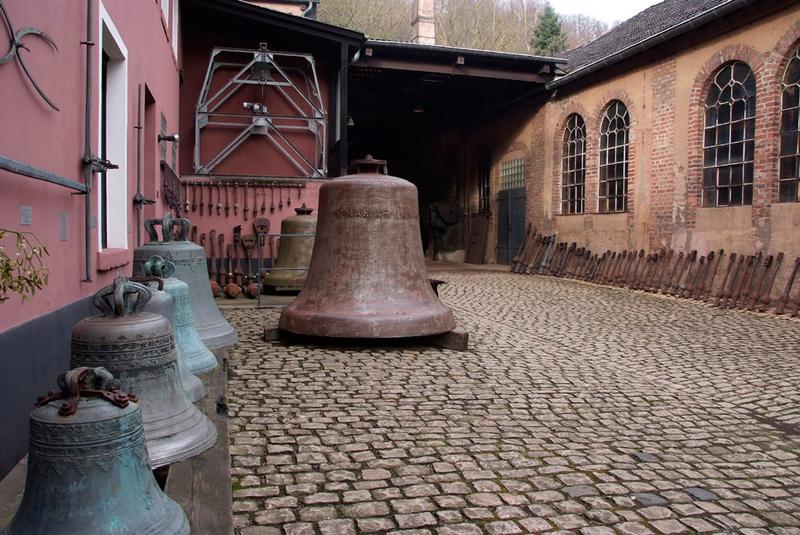Gieten

Het gieten van een klok gebeurde in deze fabriek, zij het dat bepaalde handelingen in de loop van de tijd gemechaniseerd zijn, nog merendeels precies als in de vorige eeuwen, namelijk door op een gemetselde kern een kleilaag te leggen met behulp van een ronddraaiende mal (rib), die te bakken en daarop een “valse” klok te draaien.

Deze valse klok wordt voorzien van opschriften, versieringen en medaillons van was. Daartegen wordt de mantel gebakken. Na het opheffen van de mantel wordt de valse klok weggebroken (men spreekt daarom ook wel van een “verloren vorm-model” of “cire-perdue”) en herplaatst men de mantel. De ontstane holle ruimte wordt, meestal van bovenaf, volgegoten met brons. De “klokspijs” bestaat uit 78% koper en 22% tin. Soms laat men de valse klok achterwege en gebruikt men stalen kernen en mantels waartegen de klei wordt gelegd. Ook is al gebruik gemaakt van beton.
De klokspijs wordt verhit tot 14 ŕ 1500 graden Celsius. Soms worden met gebruik van gietkanalen 6 of meer klokken tegelijkertijd of direct na elkaar gegoten. Na afkoelen wordt de klok uitgegraven, van vuil ontdaan en (eventueel) gezandstraald.
Bij de gietdemonstratie in dit museum wordt een “fonte au sable” of “zandsmeltwerk” toegepast. Deze vorm van gieten werd ook al in de Oudtijd toegepast. Het oorspronkelijke model blijft daarbij bestaan (is dus tegengesteld aan de verloren vorm).
Carillon
A carillon or chime is a tower-musical instrument consisting of 2-4 or 5 octaves, chromatically tuned bells (chromatic with half tones on or off). The ideal arrangement is a wooden or iron chair, with clocks on rows, the largest below and the smallest at the top. The clocks must hang close together. On both sides of the bells are the racks with tumblers. The name Carillon is only used when the number is at least 30 (less than 2.5 octaves) and the instrument can be played by a stick keyboard. Preferably at least 47 clocks are suspended (is then 4 octaves).
The carillon art originated in the Netherlands, at the end of the 14 e century. There was then a mechanical arrangement of three bells that showed some tones, in the same way as the chimes with the famous Westminsterlag, as a warning that the hourly battle would soon follow. These three bells and the battle clock were called a “quadrillon” , from which later “carillon” originated.
From the mechanics in the way of a music box, first came the mechanical reproduction of melodies (1400). When the number of clocks extended to about 20 (1550), the hobby of the hand game also came up through rows (top and bottom keys like the piano).
But it was not until 1640 that the bells’ voice was controlled by the Hemony brothers in such a way that they could play perfectly chromatically.
The clocks from that time on exerted a great influence on the improvement of the mechanics and the game.
Carriers who were purely in the proportional mood came first from England (Taylor, Gillett and Johnston), but later (after 1923) also from the Netherlands, including from this factory. The Dutch bell founders, however, only succeeded in the sixties to match the purity of the English bell founders.
The first pure-tuned carillon that was made in Heiligerlee in the company was destined for Rhenen (Cuneratoren). This carillon was claimed by the Germans in the Second World War and melted into weaponry. In 1958 Van Bergen once again made a carillon for the Cuneratoren in Rhenen.